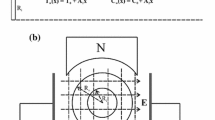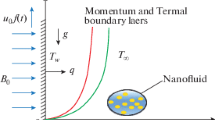Abstract
This work aims to characterize the heat exchange system efficiency and entropy generation of nanofluid forced convection flow with chaotic perturbations influenced by a non-uniform magnetic field. The study investigates numerically the effects of combined passive/active methods presented in terms of chaotic advection, nanoparticles and non-uniform magnetic field on the fluid flow performances. Adopted parameters for the characterization are the convection heat transfer coefficient, field synergy principle, entropy production and efficiency according to the first and second law of thermodynamics. Several parameters were used to evaluate the current study, such as Hartmann and Reynolds numbers, concentration of nanoparticles as well as the mode of application and orientation of the magnetic field. The main results show that the co-effect of the magnetic intensity (Ha), its orientation (transversal) besides with its application mode (partial) stimulate the performance of such energy systems. Furthermore, the production of entropy in laminar regime is due only to the thermal irreversibilities, while the produced ones by friction and magnetic field are insignificant. Using the second law of thermodynamics, exergetic efficiency is dominated by heat transfer since the first law of thermodynamics overestimates the pressure drops in the flow.



















Similar content being viewed by others
Abbreviations
- A :
-
Area of the cross section, m2
- A L :
-
Lateral surface of the duct, m2
- \(\vec{B}\) :
-
Magnetic field
- B 0 :
-
The magnetic field strength, Tesla
- Be:
-
Bejan number
- C p :
-
Specific heat, J kg−1 K−1
- D h :
-
Hydraulic diameter, m
- Ec:
-
Eckert number
- Ha:
-
Hartmann number
- h :
-
Coefficient of convection heat transfer, W m−2 K−1
- k :
-
Thermal conductivity, W m−1 K−1
- Nu:
-
Nusselt number
- p :
-
Pressure, Pa
- P :
-
Dimensionless pressure
- Pr:
-
Prandtl number
- q :
-
Heat flux density, W m−2
- Ra:
-
Rayleigh number
- Re:
-
Reynolds number
- S :
-
Entropy, W K−1
- l :
-
Unfolded length of the duct, m
- u, v, w :
-
Velocities following x, y, z coordinates, m s−1
- U, V, W :
-
Non-dimensional velocities
- T :
-
Temperature, K
- x, y, z :
-
Cartesian coordinates, m
- X, Y, Z :
-
Non-dimensional coordinates
- α :
-
Thermal diffusivity, m2 s−1
- β :
-
Thermal expansion coefficient, K−1
- θ :
-
Dimensionless temperature
- ρ :
-
Fluid density, kg m−3
- σ :
-
Electrical conductivity, Ω−1 m−1
- \(\emptyset\) :
-
Solid volume fraction
- µ :
-
Dynamic viscosity, kg s−1 m−1
- ν :
-
Kinematic viscosity, m2 s−1
- γ :
-
Inclination angle of magnetic field
- δ :
-
Standard deviation
- ϑ :
-
Synergy angle
- c:
-
Cold
- f:
-
Fluid
- h:
-
Hot
- L:
-
Local
- m:
-
Average
- nf:
-
Nanofluid
- s:
-
Solid
References
Siricharoenpanich A, Wiriyasart S, Srichat A, Naphon P. Thermal cooling system with Ag/Fe3O4 nanofluids mixture as coolant for electronic devices cooling. Case Stud Therm Eng. 2020;20:100641.
Wang Y, Wang B, Zhu K, Li H, He W, Liu S. Energy saving potential of using heat pipes for CPU cooling. Appl Therm Eng. 2018;143:630–8.
Sadeghianjahromi A, Wang CC. Heat transfer enhancement in fin-and-tube heat exchangers—a review on different mechanisms. Powder Technol. 2021;137:110470.
Fares M, AL-Mayyahi M, AL-Saad M. Heat transfer analysis of a shell and tube heat exchanger operated with graphene nanofluids. Case Stud Therm Eng. 2020;18:100584.
Bezaatpour M, Rostamzadeh H. Simultaneous energy storage enhancement and pressure drop reduction in flat plate solar collectors using rotary pipes with nanofluid. Energy Build. 2021;239:110855.
El Omari K, Le Guer Y. Thermal chaotic mixing of power-law fluids in a mixer with alternately rotating walls. J Non-Newtonian Fluid Mech. 2020;165:641–51.
Belahmadi E, Bessaih R. Entropy generation analysis of nanofluid natural convection in coaxial cylinders subjected to magnetic field. Therm Sci. 2019;23:3467–79.
Boukhalkhal AL, Lasbet Y, Makhlouf M, Loubar K. Numerical study of the chaotic flow in three-dimensional open geometry and its effect on the both fluid mixing and heat performances. Int J Heat Technol. 2017;35:1–10.
Hossain S, Lee I, Kim SM, Kim KY. A micromixer with two-layer serpentine crossing channels having excellent mixing performance at low Reynolds numbers. Chem Eng J. 2017;327:268–77.
Stroock AD, Dertinger SKW, Ajdari A, Mezić I, Stone HA, Whitesides GM. Chaotic mixer for microchannels. Science. 2002;295:647–51.
Selimefendigil F, Öztop HF. Forced convection in a branching channel with partly elastic walls and inner L-shaped conductive obstacle under the influence of magnetic field. Int J Heat Mass Transf. 2019;144:118598.
Ahlborn B, Lefrancois M, Seto M. Energy cascade mechanism for fully developed turbulence. Phys Lett A. 1990;150:286–9.
Kaci HM, Lemenand T, Della Valle D, Peerhossaini H. Effects of embedded streamwise vorticity on turbulent mixing. Chem Eng Process. 2009;48:1457–74.
Kumar V, Nigam KDP. Laminar convective heat transfer in chaotic configuration. Int J Heat Mass Transf. 2007;50:2469–79.
Lasbet Y, Aidaoui L, Loubar K. Effects of the geometry scale on the behaviour of the local physical process of the velocity field in the laminar flow. Int J Heat Technol. 2016;34:439–45.
Naas TT, Lasbet Y, Aidaoui L, Boukhalkhala AL, Loubar K. High performance in terms of thermal mixing of non-Newtonian fluids using open chaotic flow: numerical investigations. Therm Sci Eng Prog. 2020;16:100454.
Liu RH, Stremler MA, Sharp KV, Olsen MG, Santiago JG, Adrian RJ, Aref H, Beebe DJ. Passive mixing in a three-dimensional serpentine microchannel. J Microelectromech Syst. 2000;9:190–7.
Lasbet Y, Auvity B, Castelain C, Peerhossaini H. Thermal and hydrodynamic performances of chaotic mini-channel: application to the fuel cell cooling. Heat Transfer Eng. 2007;28:795–803.
**a GD, Liu R, Wang J, Du M. The characteristics of convective heat transfer in microchannel heat sinks using Al2O3 and TiO2 nanofluids. Int Commun Heat Mass Transf. 2016;76:256–64.
Mahian O, Kolsi L, Amani M, et al. Recent advances in modeling and simulation of nanofluid flows—part I: fundamental and theory. Phys Rep. 2019;790:1–48.
Sathiyamoorthy M, Chamkha A. Effect of magnetic field on natural convection flow in a liquid gallium filled square cavity for linearly heated side wall(s). Int J Therm Sci. 2010;49:1856–65.
Oztop HF, Al-Salem K. A review on entropy generation in natural and mixed convection heat transfer for energy systems. Renew Sustain Energ Rev. 2012;16:911–20.
Selimefendigil F, Oztop HF. MHD Pulsating forced convection of nanofluid over parallel plates with blocks in a channel. Int J Mech Sci. 2019;157–158:726–40.
Aidaoui L, Lasbet Y, Selimefendigil F. Improvement of transfer phenomena rates in open chaotic flow of nanofluid under the effect of magnetic field: application of a combined method. Int J Mech Sci. 2020;179:105649.
Bezaatpour M, Rostamzadeh H. Heat transfer enhancement of a fin-and-tube compact heat exchanger by employing magnetite ferrofluid flow and an external magnetic field. Appl Therm Eng. 2020;164:114462.
Bahiraei M, Gharagozloo K, Alighardashi M, Mazaheri N. CFD simulation of irreversibilities for laminar flow of a power-law nanofluid within a minichannel with chaotic perturbations: an innovative energy-efficient approach. Energy Convers Manag. 2017;144:374–87.
Selimefendigil F, Oztop HF. Natural convection and entropy generation of nanofluid filled cavity having different shaped obstacles under the influence of magnetic field and internal heat generation. J Taiwan Inst Chem Eng. 2015;56:42–56.
Selimefendigil F, Öztop HF, Abu-Hamdeh N. Natural convection and entropy generation in nanofluid filled entrapped trapezoidal cavities under the influence of magnetic field. Entropy. 2016. https://doi.org/10.3390/e18020043.
Bejan A. Second law analysis in heat transfer. Energy. 1980;5:721–32.
Bahiraei M, Mazaheri N, Bakhti A. Irreversibility characteristics of nanofluid flow under chaotic advection in a minichannel for different nanoparticle types. J Taiwan Inst Chem Eng. 2018;88:25–36.
Bezaatpour M, Rostamzadeh H. Magnetic-induced nanoparticles and rotary tubes for energetic and exergetic performance improvement of compact heat exchangers. Powder Technol. 2021;377:396–414.
Mehrez Z, El Cafsi A, Belghith A, Le Quéré P. MHD effects on heat transfer and entropy generation of nanofluid flow in an open cavity. J Magn Magn Mater. 2015;374:214–24.
Fersadou I, Kahalerras H, El Ganaoui M. MHD mixed convection and entropy generation of a nanofluid in a vertical porous channel. Comput Fluids. 2015;121:164–79.
Hussain S, Ahmed SE, Akbar T. Entropy generation analysis in MHD mixed convection of hybrid nanofluid in an open cavity with a horizontal channel containing an adiabatic obstacle. Int J Heat Mass Transf. 2017;114:1054–66.
Al-Rashed AAA, Ranjbarzadeh R, Aghakhani S, Soltanimehr M, Afrand M, Nguyen TK. Entropy generation of boehmite alumina nanofluid flow through a minichannel heat exchanger considering nanoparticle shape effect. Phys A. 2019;521:724–36.
Mahmoudi AH, Pop I, Shahi M. Effect of magnetic field on natural convection in a triangular enclosure filled with nanofluid. Int J Therm Sci. 2012;59:126–40.
Brinkman H. The viscosity of concentrated suspensions and solutions. J Chem Phys. 1952;20:571–81.
Maxwell J. A treatise on electricity and magnetism. Oxford: Oxford University Press; 1873.
Calcagni B, Marsili F, Paroncini M. Natural convective heat transfer in square enclosures heated from below. Appl Therm Eng. 2005;25:2522–31.
Sheikholeslami M, Shamlooei M. Convective flow of nanofluid inside a lid driven porous cavity using CVFEM. Phys B. 2017;521:239–50.
Cui W, Mao D, Lin B, Yang J. Field synergy analysis on the mechanism of heat transfer enhancement by using nanofluids. Case Stud Therm Eng. 2019;16:100554.
Guo ZY, Li DY, Wang BX. A novel concept for convective heat transfer enhancement. Int J Heat Mass Transfer. 1998;41:2221–5.
Habchi C, Lemenand T, Della Valle D, Pacheco L, Le Corre O, Peerhossaini H. Entropy production and field synergy principle in turbulent vertical flows. Int J Therm Sci. 2011;50:2365–76.
Li F, Zhu W, He H. Numerical optimization on microchannel flow and heat transfer performance based on field synergy principle. Int J Heat Mass Transf. 2019;130:375–85.
Jiaqiang E, **aohuan Z, Haili L, Jianmei C, Wei Z, Qingguo P. Field synergy analysis for enhancing heat transfer capability of a novel narrow-tube closed oscillating heat pipe. Appl Energy. 2016;175:218–28.
Castelain C, Lasbet Y, Auvity B, Peerhossaini H. Experimental study of the thermal performance of chaotic geometries for their use in PEM fuel cells. Int J Therm Sci. 2016;101:181–92.
Acknowledgements
This research was supported by the directorate general DGRSDT under the authority of the Algerian Ministry of high education and scientific research.
Author information
Authors and Affiliations
Corresponding author
Additional information
Publisher's Note
Springer Nature remains neutral with regard to jurisdictional claims in published maps and institutional affiliations.
Rights and permissions
About this article
Cite this article
Aidaoui, L., Lasbet, Y. & Selimefendigil, F. Effect of simultaneous application of chaotic laminar flow of nanofluid and non-uniform magnetic field on the entropy generation and energetic/exergetic efficiency. J Therm Anal Calorim 147, 5865–5882 (2022). https://doi.org/10.1007/s10973-021-10905-0
Received:
Accepted:
Published:
Issue Date:
DOI: https://doi.org/10.1007/s10973-021-10905-0




